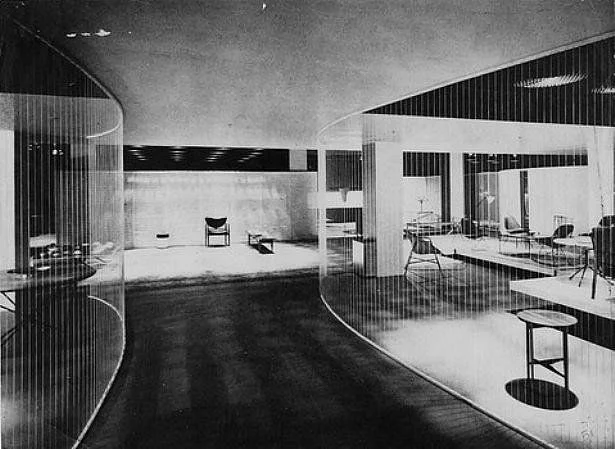Welcome to the Archives of The Paul Rudolph Institute for Modern Architecture. The purpose of this online collection is to function as a tool for scholars, students, architects, preservationists, journalists and other interested parties. The archive consists of photographs, slides, articles and publications from Rudolph’s lifetime; physical drawings and models; personal photos and memorabilia; and contemporary photographs and articles.
Some of the materials are in the public domain, some are offered under Creative Commons, and some are owned by others, including the Paul Rudolph Estate. Please speak with a representative of The Paul Rudolph Institute for Modern Architecture before using any drawings or photos in the Archives. In all cases, the researcher shall determine how to appropriately publish or otherwise distribute the materials found in this collection, while maintaining appropriate protection of the applicable intellectual property rights.
In his will, Paul Rudolph gave his Architectural Archives (including drawings, plans, renderings, blueprints, models and other materials prepared in connection with his professional practice of architecture) to the Library of Congress Trust Fund following his death in 1997. A Stipulation of Settlement, signed on June 6, 2001 between the Paul Rudolph Estate and the Library of Congress Trust Fund, resulted in the transfer of those items to the Library of Congress among the Architectural Archives, that the Library of Congress determined suitable for its collections. The intellectual property rights of items transferred to the Library of Congress are in the public domain. The usage of the Paul M. Rudolph Archive at the Library of Congress and any intellectual property rights are governed by the Library of Congress Rights and Permissions.
However, the Library of Congress has not received the entirety of the Paul Rudolph architectural works, and therefore ownership and intellectual property rights of any materials that were not selected by the Library of Congress may not be in the public domain and may belong to the Paul Rudolph Estate.
LOCATION
Address: 11 West 53rd Street
City: New York
State: New York
Zip Code: 10019
Nation: United States
LOCATION
Address: 222 West Merchandise Mart Plaza
City: Chicago
State: Illinois
Zip Code: 60654
Nation: United States
STATUS
Type: Exhibition
Status: Built
TECHNICAL DATA
Date(s): 1951
Site Area:
Floor Area:
Height:
Floors (Above Ground):
Building Cost:
PROFESSIONAL TEAM
Client: The Merchandise Mart; The Museum of Modern Art (MoMA)
Architect: Paul M. Rudolph
Associate Architect:
Landscape:
Structural:
MEP:
QS/PM:
SUPPLIERS
Contractor:
Subcontractor(s):
Good Design Exhibition of 1952
‘GOOD DESIGN’ is a series of exhibitions of home furnishings, organized by the Museum of Modern Art in New York City for the Merchandise Mart of Chicago, Illinois. Edgar Kaufman, Jr. is appointed by the Museum as the Director of the program.
‘GOOD DESIGN’ begins in January 1950 and Mr. Edgar Kaufman, Jr. is appointed by the Museum as the Director of the program and Chairman of the Selection Committee for the items that are to be displayed in the exhibit. He is joined by F. Carlton Ball (a potter and designer from Southern Illinois University), Gordon F. Fraser (a merchandiser of modern products from California), Harry Weese (Chicago architect) and Charles Zadok (the head of Gimbels’ department store in Milwaukee).
A setting is created for the exhibit each January in Chicago and each fall in New York by a prestigious designer or architect appointed annually by the Museum of Modern Art. Charles and Ray designed the 5,300-square-foot space for the inaugural installation in 1950 in Chicago, followed by Finn Juhl (1951), Paul Rudolph (1952), Alexander Girard (1953), and Daniel Brenner and A. James Spire (1955).
The New York version of ‘GOOD DESIGN’ is held at the Museum of Modern Art, usually on the ground floor for about eight weeks. About 3,000 square feet is available for the exhibit, and fewer items are shown in New York than at the Chicago event due to the smaller venue.
The project scope is to design a layout for the third annual ‘GOOD DESIGN’ exhibition to be held at the Museum of Modern Art in New York City and the Merchandise Mart in Chicago, Illinois.
On November 26, 1951 the Museum of Modern Art and the Merchandise Mart issue a press release announcing a December 10, 1951 deadline to receive items to be displayed in the exhibit. Included in the press release is that ‘Paul Rudolph will install the 1952 Exhibition,’ along with a short biography.
The design teams selects 250 items to be displayed during the event, adding a few which were held over from the 1951 show.
At the time of the commission, Rudolph is teaching at the School of Fine Arts at the University of Pennsylvania.
The exhibit is open on the eleventh floor of the Merchandise Mart in Chicago beginning January 10, 1952.
The exhibit opens at the Museum of Modern Art in New York City from September 23 – November 30, 1952 with approximately 225 items of home furnishings installed in the first floor galleries of the Museum. It is the 9th GOOD DESIGN showing in the three years of collaboration between the Museum and the Merchandise Mart at the time of the event.
“The architecture firm of Rudolph and Twitchell would be best qualified, first, because they, being a Florida concern, would bring geographical representation to the exhibits, second, because their work was not too well known and over publicized in the north, and third, because recent pictorial coverage of their work in magazines indicated they would do an outstanding job.”
“A special installation for the New York show is being designed by Paul Rudolph who also installed the Chicago exhibition. Mr. Rudolph, a young Florida architect, has come here especially for this purpose. A curved grille of plastic and large transparent screens will divide but not confine the space. Lighting will contrast bright areas with darker ones providing alternate backgrounds to accent the products shown.”
DRAWINGS - Design Drawings / Renderings
DRAWINGS - Construction Drawings
DRAWINGS - Shop Drawings
PHOTOS - Project Model
PHOTOS - During Construction
PHOTOS - Completed Project
PHOTOS - Current Conditions
LINKS FOR MORE INFORMATION
The Good Design Awards website
RELATED DOWNLOADS
PROJECT BIBLIOGRAPHY
Arthur J. Pulos. The American Design Adventure. MIT Press, 1990.
Charles R. Smith. Paul Rudolph and Louis Kahn: A Bibliography. The Scarecrow Press, Inc., 1987.
“Chronological List of Works by Paul Rudolph, 1946-1974.” Architecture and Urbanism, no. 49, Jan. 1975.
Darby English and Charlotte Barat. Among Others: Blackness at MoMA. The Museum of Modern Art, 2019.
“Display Techniques.” Progressive Architecture, no. 33, 33, Oct. 1952.
“Good Design 1952: Rudolph’s Installation Gets Raves.” Architectural Record, no. 111, 111, Mar. 1952.
“Good Design Exhibition: Installation by Paul Rudolph.” Arts and Architecture, no. 69, 69, May 1952.
Klaus Franck. Exhibitions: A Survey of International Designs. Frederick A. Praeger, 1961.
Museum of Modern Art. The Musdeum of Modern Art at Mid-Century - At Home and Abroad. Edited by John Szarkowski and John Elderfield, Museum of Modern Art, 1995.
“New York Version.” Interiors, no. 112, 112, Nov. 1952.
Olga Gueft. “Good Design in Chiaroscuro: Paul Rudolph Designs the Mart’s Third Exhibition.” Interiors, no. 111, 111, Mar. 1952.








